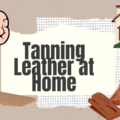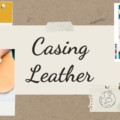Leather is a durable material for almost all kinds of garments, furniture, and even fashion accessories. Because of its natural heat resistance, leather is also worn as protective clothing like boots and jackets. But how well can leather withstand high temperatures? Let us find out when and how leather will burn and what circumstances we need to burn them.
A genuine leather, like veg-tanned leather, rarely burns because of its natural heat resistance. Artificial leathers burn easily and will produce smoke which can be dangerous to the health when inhaled. One known application of burning leather is its use as a decorative design in leather products.
This article will talk about why leather rarely burns and the effects of fire on genuine and artificial leather. I will also discuss the difference when the leathers are exposed to high temperatures and whether it is bad to burn them. Lastly, I included a section about one of the most known applications of leather burning, which is very beneficial for all leatherworkers as a decorative design in their projects.
Genuine Leather Does Not Easily Burn

Genuine leathers are not non-flammable materials, but they are highly resistant to heat; that is why they are tough to burn. They will only shrink and curl when exposed to flame, but they hardly catch flame and burn. When the flame is removed in its contact, the burning of leather stops. It will take a great amount of flame for leather to be engulfed in it.
Authentic leathers are made from animal hides which have similar characteristics to human skin. The structure and intermolecular bonding of the leather fibers are naturally heat-resistant. These hides have pores and absorb moisture, which is why it does not easily catch fire. However, over time if a leather product is not cared for, it may lead to dryness, cracking, and peeling and decrease its fire-resistant capacity. Some common animals where genuine or authentic leathers are made are cows, horses, goats, deers, and alligators.
Another reason why genuine leathers are fire-resistant is that original leathers have higher flashpoints than imitation ones. Fake leather contains a mixture of plastic, polyvinyl chloride, and many other highly flammable chemicals. As for genuine leather, they have high water content, which is natural for animal skins.
Instances When Leather Burns

Genuine leather rarely burns even if they are often exposed to heat. However, there are instances that leather is burned for a specific purpose which I will be discussing in this section.
Leather Burns When Exposed to High Temperature
The temperature at which leather starts to burn differs depending on the type of leather and its finish. The vegetable-tanned leather will start to shrink at 390 degrees Celsius and melt around 550 degrees Celsius when placed over a fire for 10 seconds or more. Chrome-tanned leather, which uses chromium salts in tanning, contains less moisture and is often dried of its natural oils. They may start to burn at 450 degrees Celsius when placed above the fire for 5-8 seconds. Burnt leather smells like burnt hair being the natural skin of an animal.
Imitation or artificial leather melts at high heat and burns well. Other terms used for leather that are not genuine are faux leather, fake leather, leatherette, synthetic leather, and man-made leather. They are often used in upholstery such as motorcycle seats, cushions, and many parts of the medical field. Artificial leather burns easier compared to genuine leather, which will still be fine at 350 degrees Celsius. Burnt artificial leather smells a lot like burnt plastic and is not good to be inhaled.
Burning Leather as a Decorative Technique

Burning genuine leather is not bad. One decorative technique in leather is pyrography. Leather pyrography is the burning of designs on the grain surface of the leather using scorching tools or pyrography kits. The modern application of pyrography is more inclined towards artistic designs rather than writing on leather.
Pyrography is best done on vegetable-tanned leather or any genuine leather which are not chemically produced; hence no amount of toxic smoke will be produced. Veg-tanned leather accepts burning beautifully on its surface.
Since genuine leather does not contain chemicals, the smoke produced while burning the designs will not be harmful to the leatherworker. Always bear in mind to avoid using synthetic leather on this technique. Since pyrography is a meticulous process and often requires a long time to finish, being exposed to the smoke from burning synthetic leather is severely dangerous to your health.
The technique of burning design on leather is a creative way to style your leather products. The tip of the burning tool sinks well on the grain side of leather allowing you to imprint designs with ease. You can also create amazing tones and shades, highlighted and shadowed designs of cinematic views on leather. The end product of leather pyrography displays an aesthetic and beautiful sepia appearance that highlights original leather features. The temperature required for the burning tool to effectively create a burn impression on leather ranges from 200 to 400 degrees Celsius, depending on the design requirement.
Fire-Testing to Test the Authenticity of a Leather
Another use of burning leather is to determine fake from authentic leather products. Applying fire in leather determines its authenticity. When exposed to flame, fake or imitation leather products easily catch fire and produce the smell of burning plastic.
Original leather, which directly comes from animal hides, is treated naturally. When exposed to heat and flame, they shrink in size and release a smell of burnt hair which is not dangerous when inhaled. So next time you’re in doubt, fire-testing for authenticity is the way to go.
Natural Leather Is Safe to Burn
As natural leather comes from authentic animal hides, which are known to be very durable skin that protects animals, burning them would not cause any harm to us leatherworkers. And there are very few processes in leatherworking that require burning it because of its natural resistance to fire and heat.
Burning Natural Vs. Artificial Leather

Burning leather is not bad if they are used for creating designs on natural leather. Natural and genuine leather is safe to burn, and the smoke which comes from burning it will not cause any serious health problems. This is because the leather is treated with natural tanning agents like tree bark and animal brains, all-natural and non-toxic.
Artificial leather is not safe to burn. It contains harmful chemicals used in its tanning process, such as metals and possibly aniline dyes which are all toxic. When inhaled, smoke from burning artificial leather may irritate the eyes and throat.
Genuine Leather are Not Needed to be FR Treated
Natural or genuine leather does not need to be FR treated. FR means fire-resistant. The material checking is done to know how easily a material can catch fire. The treatment is applied to fabrics which adds flame resistance to the fabric fibers and chemically changes the fabric to give it a flame-resistant finish.
Genuine leathers are naturally able to resist heat, therefore also contributing to it being fire-resistant. All pure leather comes from animal hides without chemical treatments so they are no longer needed to be FR treated as they do not contain any flammable chemicals that may cause harm when exposed to high temperatures.
How to Fix Burns in Synthetic Leather
Let us talk about fixing burns in synthetic leather. The common leather pieces which experience burning are products for upholstery, such as furniture upholstery and leather seats in cars and motorcycles. These pieces are often ruggedly used and produced as heavy-duty products. Furniture upholstery leathers such as nubuck, pure aniline, or pigmented leather are genuine leathers that scrunch up a bit when exposed to high heat. However, pieces such as faux, naugahyde, pleather, bonded, or leatherette are artificial leathers that are not fire-resistant.
Burns from these pieces came from being too exposed to heat or cigarette burns. To fix a burned part of your leather product, you can follow these simple instructions. The first step is removing the burned part. Scrape the layer of the damaged leather until no crispy parts of it are left. You may use a sharp knife or a razor blade here. Just be careful not to cut the undamaged leather. Then, apply heavy filler on the burned part. Heavy filler is a paste used in leather car seats and furniture. Apply a few layers of this paste until the burned leather feels smooth and moist. After this, dry the spot using a blow dryer.
For the final touches, put the touch-up paint on the burned part, just enough to cover the damage. Touch-up paint is available in various colors for your burned leather pieces. If you cannot find the exact color for your furniture, you can purchase kits that let you mix your own paint to produce the exact color. Applying touch-up paint is a much cheaper remedy than going to service centers.
Conclusion
There are a couple of good reasons why you would want or need to burn leather, and there are some bad sides to it. Burning genuine leather will not do you any harm and can also be an excellent technique in leather designs. However, if you can avoid it, stay away from burning synthetic leather as they pose a serious risk to your health and safety when exposed to high temperatures and fire.













